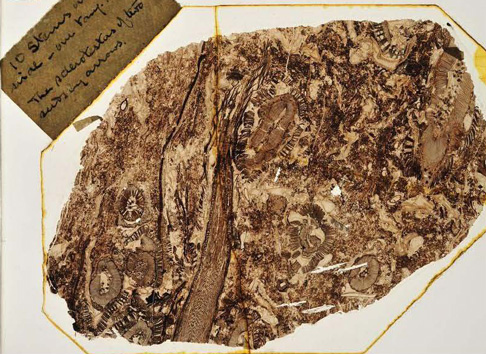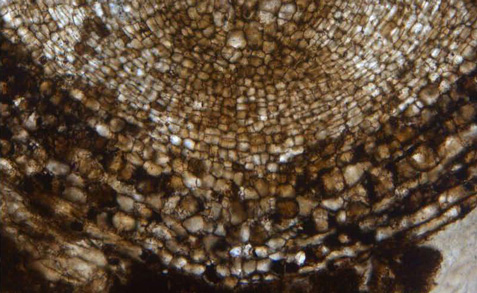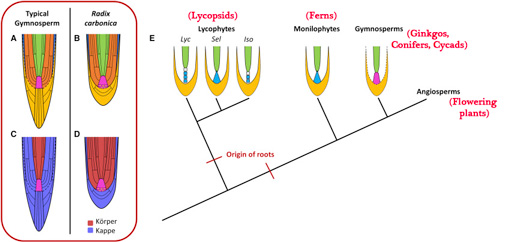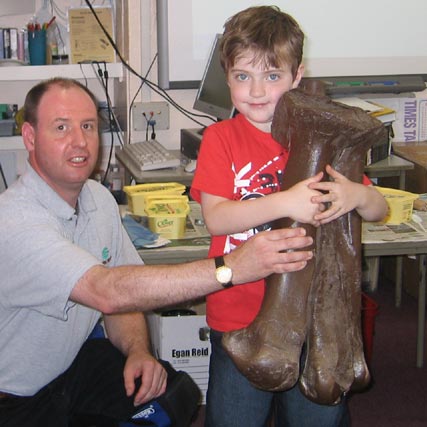Scientists “Root Out” Oldest Plant Root Cells
Oldest Plant Roots Identified
Scientists from Oxford University and the Departamento de Biología Molecular de Plantas, Instituto de Biotecnología, Universidad Nacional Autónoma de México (Mexico), have identified the oldest known population of plant root cells in a 320-million-year-old fossil. This study, published as an on-line, open access article, highlights the importance of historical collections such as the Oxford University Herbaria, which as part of the University’s Plant Sciences Department, houses an extensive botany collection, with some specimens within the archive over 300 years old.
Oldest Fossil Plant Roots
A Slide Showing Preserved Plant Remains from the Oxford University Herbaria Collection
Picture credit: Oxford University Herbaria
The picture above shows a thin soil slice prepared on a slide over 100 years ago and part of the Oxford University Herbaria collection. The fossilised soil is estimated to be around 320 million-years-old and shows the cellular anatomy of plants which were growing and decaying in the fossil soil underlying the Carboniferous coal swamp forests.
The scientists have not only revealed the oldest plant root stem cells found to date, the research also marks the first time an actively growing fossilised root has been discovered and it shows that plant root cell division in the past may have been more diverse than today.
Roots and Shoots – Getting to the Root of the Problem
The roots and shoots of plants develop from specialised groups of cells called meristems. These self renew and produce cells that undergo differentiation. The organisation of these cells changes when growth stops, so up until this research was published, it was impossible to compare the fossil record with the cellular structure of actively growing meristems. Using slides from the Oxford University Herbaria that represent thin sections of fossilised soils taken from Carboniferous coal balls, researchers were able to identify the fossilised remains of an actively growing root meristem and examine in detail the stem cells and their structure. They found that the cellular organisation of the fossilised root tip is unique.
Roots and shoots of ancient plants from the Carboniferous may have grown in a broadly similar way to modern plants such as the angiosperms (flowering plants), but the unique cellular order and structure demonstrates that the meristem growth we find today may only represent a proportion of the root and shoot growth diversity that once existed. This research indicates that some of the biological processes and systems controlling the root development of plants have now become extinct.
A Highly Magnified Image Showing the Growing Root Apex Assigned to the Species Radix carbonica
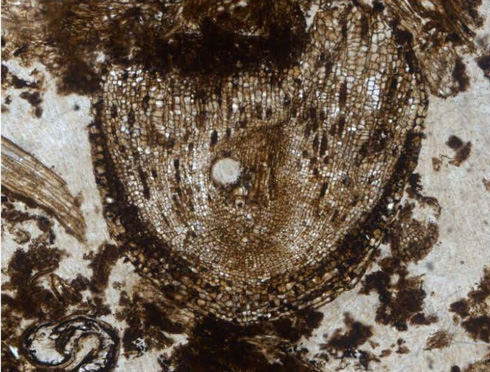
The dark horseshoe-shaped structure is the root cap protecting the growing root apex as it pushes through the soil.
Picture credit: Oxford University Herbaria
A Unique Cellular Arrangement
The structures preserved in the fossil record are similar to those found in extant species, but they are different, they represent a unique cellular arrangement not known in modern plants.
Commenting on the study, one of the authors of the paper, Oxford Plant Sciences PhD student Alexander (Sandy) Hetherington stated:
“I was examining one of the fossilised soil slides held at the University Herbaria as part of my research into the rooting systems of ancient trees when I noticed a structure that looked like the living root tips we see in plants today. I began to realise that I was looking at a population of 320-million-year-old plant stem cells preserved as they were growing – and that it was the first time anything like this had ever been found. It gives us a unique window into how roots developed hundreds of millions of years ago.”
For models and replicas of prehistoric plants: CollectA Prehistoric Life Models.
The First Global Tropical Wetland Forests
The fossil soil slides and the root structures they contain are extremely important as they provide a record of our planet’s first global tropical wetland forests. The Carboniferous swamps and wetlands were to form the extensive coal deposits found in much of the world today, including most of the coal in the United Kingdom, exploitation of which fuelled the industrial revolution.
Ancient Plants
From a biological point of view, these huge, lycopsid (club mosses), pteridosperm (seed fern) and sphenopsid (horsetails) dominated forests represent the first time deep rooting structures evolved on Earth. These root systems increased the rate of chemical weathering of the silicate minerals in rocks, a chemical reaction that pulled carbon dioxide out of the atmosphere, leading to a period of global cooling – climate change on a worldwide scale. Of the 139 slides studied, two root caps were identified. The first was assigned to a known species Lyginopteris oldhamia, a seed fern (pteridosperm), the second was an unknown species, this has been named Radix carbonica, this translates as “coal root”.
Professor Liam Dolan, (Department Head of Plant Sciences, Oxford University) and lead author of the academic paper, explained:
“These fossils demonstrate how the roots of these ancient plants grew for the first time. It is startling that something so small could have had such a dramatic effect on the Earth’s climate. This discovery also shows the importance of collections such as the Oxford University Herbaria, they are so valuable, and we need to maintain them for future generations.”
A Highly Magnified Image Showing the Root Cellular Structure
Picture credit: Oxford University Herbaria
From examining the size and number of cells which radiate out from the tip the researchers were able to establish that the root was actively growing at the time it was fossilised. This makes the finding the first and only discovery to date of the fossilised remains of an actively growing root meristem.
The Root Growth of Radix carbonica is Unique Compared to Living Plant Root Meristems
The schematic diagram below shows the cellular organisation of a typical member of the gymnosperm group (conifers, ginkgos and cycads). The colours show various major tissue types within the meristem.
Mapping the Evolution of Root Systems
Picture credit: Current Biology with additional annotation by Everything Dinosaur
The diagram above shows (A and C) the meristem of a typical gymnosperm, compared with (B and D) the meristem of Radix carbonica.
Yellow = the root cap
Pink = the promeristem (yellow lines in the R. carbonica promeristem indicate the positions of anticlinal cell divisions within the promeristem)
Orange = ground tissue
Blue = epidermis
Green = procambium
A simplified cladogram showing the hypothesised origin of roots based on this new study (E). The meristems of different types of lycopsids are compared to the evolution of ferns, gymnosperms and the path towards the flowing plants (angiosperms), that evolved later.
Everything Dinosaur acknowledges the help of a press release from the press team at Oxford University in the compilation of this article.
The paper “Unique Cellular Organization in the Oldest Root Meristem” is published in Current Biology. DOI: 10.1016/j.cub.2016.04.072.
Visit the Everything Dinosaur website: Everything Dinosaur.


